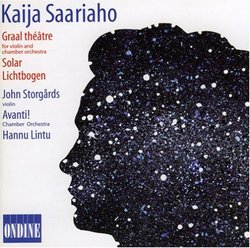| All Artists: Kaija Saariaho, Hannu Lintu, Members of Avanti Chamber Orchestra Title: Kaija Saariaho: Graal théâtre: Solar; Lichtbogen Members Wishing: 2 Total Copies: 0 Label: Ondine Original Release Date: 1/1/2002 Re-Release Date: 9/24/2002 Genre: Classical Styles: Chamber Music, Forms & Genres, Concertos, Historical Periods, Classical (c.1770-1830) Number of Discs: 1 SwapaCD Credits: 1 UPC: 761195099728 |
Search - Kaija Saariaho, Hannu Lintu, Members of Avanti Chamber Orchestra :: Kaija Saariaho: Graal théâtre: Solar; Lichtbogen
 | Kaija Saariaho, Hannu Lintu, Members of Avanti Chamber Orchestra Kaija Saariaho: Graal théâtre: Solar; Lichtbogen Genre: Classical
|
Larger Image |
CD Details |
CD ReviewsSaariaho's Shimmering Sonic Blossoms Phil Avetxori | 11/25/2003 (5 out of 5 stars) "Elegant and unorthodox, organic and uncanny, the music of Kaija Saariaho has an alien beauty that isn't compromised one iota by its resolute modernism. "Graal Theatre", for violin and chamber orchestra, is a luxuriously writhing soundscape, where the impassioned violin part has its great swoops punctuated by splashes of orchestral color. The violin here is much more up front than in the full orchestral version, which is available on Sony Classical's excellent "Chateau De L'Ame" disc of the composer's works (see my review). "Solar" inhabits a similar soundworld. Rather than complementing and dialectically engaging with a soloist, the orchestral layers and clusters of resosnant sound are free to blossom into a lush ambient hazes and florid tangles. Tempo and density vary unpredictably, but these shifts never seem random or arbitrary. These changes are written with subtelty and a balance that seems improbable, in this context. But Saariaho pulls it off. As with Debussy, her music can seem decorative and unrigorous at first. But like the impressionist master, whose lineage (in one of its tributaries) culminates in her Spectralist mentors, Saariaho lets the indistinct quality of much of her material influence the progression of its form. "Lichtbogen", the closing piece, is a compelling demonstration of this talent. Nine musicians, and their live electronic transformations of various sorts, weave a delicate study in tone and texture, with vibrating events rising from crystalline, sustained tones and electronic washes. As with all of Saariaho's work, this is highly original music." Three works that hold a somewhat minor role in her oeuvre al Christopher Culver | 04/03/2006 (3 out of 5 stars) "This 2002 Ondine disc contains three pieces by Finnish composer Kaija Saariaho, whose falling in with the spectralist school in the early 1980s led to a long obsession with timbre as the ultimate component of music. Hannu Lintu leads the Avanti! Chamber Orchestra, with a spotlight on violinist John Storgards.
"Graal Theatre", a violin concerto dedicated to Gidon Kremer, stands on the threshold of a new interest in somewhat more conventional writing. While the orchestral writing is concerned mainly with timbre, the soloist's material is often melodic. The work was originally written in 1994 for symphony orchestra, and a recording of this version with Kremer performing can be found on a Sony disc. The version here is a 1997 arrangement for chamber orchestra, which maintains the solo part unchanged but gives a more intimate feel to the work by reducing the remaining instrumentation. All in all, I like the version for full orchestra better, as it features more impressive use of percussion and it is the original version whose recording gives us the powerful work of Gidon Kremer. John Storgards just doesn't excite me as much here. However, when it comes to examining certain details of the original version, this pared-down chamber arrangement is a useful tool. "Solar" (1993), a composition for a chamber ensemble of twelve players, takes its title from the "heliocentric" nature of its harmonies: the writing forces a harmonic progression towards a fixed point as if by gravitational attraction. This is a less dramatic work than "Graal Theatre", featuring fewer ups-and-downs and staying rather sunny and busy in the first half and restrained in the second. However, it better showcases the obsession with colour of spectralist composers like Saariaho. The work was originally written for the ensemble Champ d'Action, and a recording of their performance is available on a Mode disc, but this Avanti! performance is just as fine. "Lichtbogen" (1986) comes from a fairly early stage of Saariaho's career and is typical of her output of this time in its use of live electronics and finding inspiration from a single sound. The cracking of a cello harmonic when pressure is applied to the bow was analysed with a computer, transposed to nine instrumentalists and live electronics, and then extended to a full-scale piece. This is a quiet piece where rare bright notes shine over a night sky of subdued ambience--the apt title of the piece comes from the Swedish for the Aurora Borealis. While not as immediately accessible as the first two works, it still offers pleasurable listening. This disc is probably not the best introduction to Saariaho's oeuvre. The aforementioned Sony disc with the original arrangement of "Graal Theatre" also features "Amers", a real stunner of a cello concerto (with live electronics) that I think is her masterpiece. However, for established fans this disc is worth seeking out." |

 Track Listings (4) - Disc #1
Track Listings (4) - Disc #1